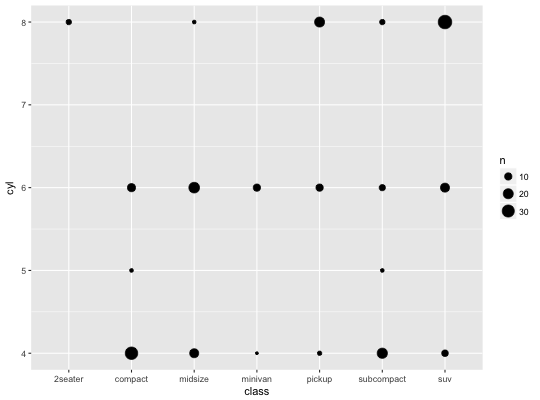Scales for area or radius
scale_size scales area, scale_radius scales radius. The size
aesthetic is most commonly used for points and text, and humans perceive
the area of points (not their radius), so this provides for optimal
perception. scale_size_area ensures that a value of 0 is mapped
to a size of 0.
scale_radius(name = waiver(), breaks = waiver(), labels = waiver(), limits = NULL, range = c(1, 6), trans = "identity", guide = "legend") scale_size(name = waiver(), breaks = waiver(), labels = waiver(), limits = NULL, range = c(1, 6), trans = "identity", guide = "legend") scale_size_area(..., max_size = 6)
Arguments
| name | The name of the scale. Used as axis or legend title. If
|
|---|---|
| breaks | One of:
|
| labels | One of:
|
| limits | A numeric vector of length two providing limits of the scale.
Use |
| range | a numeric vector of length 2 that specifies the minimum and maximum size of the plotting symbol after transformation. |
| trans | Either the name of a transformation object, or the object itself. Built-in transformations include "asn", "atanh", "boxcox", "exp", "identity", "log", "log10", "log1p", "log2", "logit", "probability", "probit", "reciprocal", "reverse" and "sqrt". A transformation object bundles together a transform, it's inverse,
and methods for generating breaks and labels. Transformation objects
are defined in the scales package, and are called |
| guide | Name of guide object, or object itself. |
| ... | Other arguments passed on to |
| max_size | Size of largest points. |
See also
scale_size_area if you want 0 values to be mapped
to points with size 0.
Examples
p + scale_size("Highway mpg")p + scale_size(range = c(0, 10))# If you want zero value to have zero size, use scale_size_area: p + scale_size_area()# This is most useful when size is a count ggplot(mpg, aes(class, cyl)) + geom_count() + scale_size_area()# If you want to map size to radius (usually bad idea), use scale_radius p + scale_radius()





